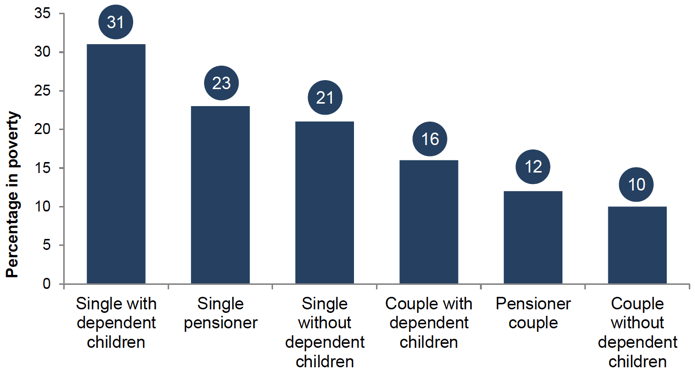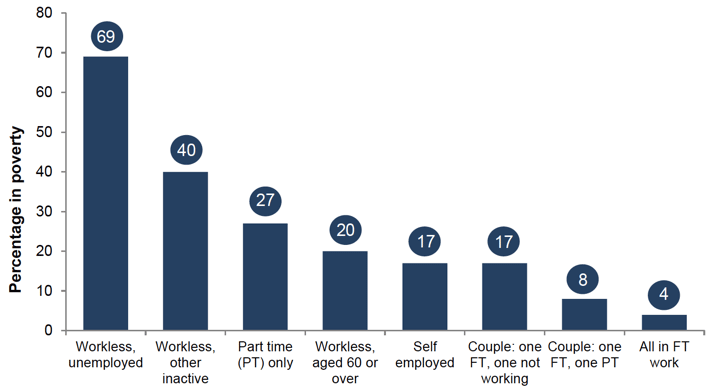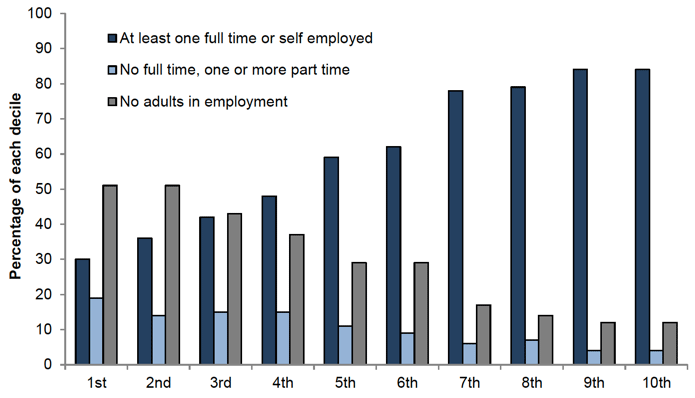Poverty and Income Inequality in Scotland 2015/16
Estimate of the number and proportion of people living in poverty in Scotland in the financial year 2015/16.
Chapter 3: Household characteristics and income distribution
3.1 Household composition
Key points:
- Lone parents were at greatest risk of poverty BHC and also saw the largest increase in relative poverty BHC, increasing by seven percentage points to 31 per cent. This is the second large increase in succession.
- The bottom decile saw an increase in the percentage of households with at least one adult in employment driven by increases in part-time employment. Deciles 2 to 6 saw decreases in the percentage of households with at least one adult in employment mainly driven by decreases in full-time employment.
- The percentage of households with either no adults in employment or one or more adults unemployed in the bottom decile continued to fall. This was accompanied by an increase in those in part-time employment.
- 51 per cent of those in the bottom decile are in households with no adults in employment, a decrease of six percentages points on the previous year. This reflects the move into employment and the decrease in the number of workless households.
- Families with someone in employment make up 52 per cent of those in the bottom three deciles, an increase of one percentage point on the previous year.
Chart 14 - Risk of poverty BHC by household type - 2015/16

Source: HBAI dataset, DWP. These figures are also presented in Annex 1 (Table A11).
Commentary:
As in 2014/15 lone parents were most at risk of being in relative poverty BHC with almost one third of those in lone parent households being in poverty. This group also saw the largest increase in relative poverty BHC, increasing by 7 percentage points from 24 per cent in 2014/15. This is the second consecutive year in which there has been a large increase in the risk of poverty for lone parents and follows a large decrease in 2013/14.
Looking across the income deciles almost three fifths (58 per cent) of lone parent households are in the bottom 3 income deciles whilst only 7 per cent are in the top 3 deciles.
Single pensioners were also prevalent towards the lower end of the income distribution with 45 per cent of all single pensioners found in the bottom 3 income deciles. Relative poverty BHC for single pensioners remained steady at 23 per cent and this group remained at the second highest risk of poverty, albeit well below the level for lone parents.
Couple households were at lower risk of poverty compared to households headed by single adults. Couple households may be more able to increase household income than single person households, as there is the potential for both adults to earn income from employment.
Sixteen per cent of people in couple households with children were in poverty. These households are fairly evenly distributed across the income deciles.
Couple households without children were the most likely to be at the top end of the income distribution and only 10 per cent of people in this group were in poverty BHC.
Couple households without children may be able to work more hours and have greater flexibility in the labour market than those with children. In addition any income they have need not be shared with direct dependants. Households without children are also able to move out of the welfare system more quickly than those with children, at which point any increases in earnings do not trigger decreases in benefit income.
3.2 Household economic status
Chart 15 shows the risk of relative poverty BHC by household economic status while chart 16 shows the employment characteristics of households in each decile. In chart 16 each bar represents the percentage of people in that decile living in each of the following households types: at least one adult in full-time employment, part-time employment only, no adults in employment (whether due to unemployment, not actively seeking employment, or retirement).
Chart 15 - Risk of poverty BHC by economic status of household - 2015/16

Chart 16 - Economic status of household, composition of each decile in 2015/16

Source: HBAI dataset, DWP. These figures are also presented in Annex 1 (Table A13).
Commentary:
Poverty rates are highest amongst unemployed or otherwise inactive households. Sixty-nine per cent of those living in an unemployed household and 40 per cent of those in otherwise inactive households were in relative poverty BHC in 2015/16.
Households where no-one is working either through unemployment, retirement or economic inactivity (those who are neither in work, nor looking for work) were more common towards the bottom of the income distribution. Fifty-one per cent of those in the bottom decile were in households with no adults in employment, a decrease of six percentage points on the previous year.
While poverty rates are lower for households in employment, employment is not always a protection against poverty, especially for households with part-time workers or in which one adult works and one does not.
In 2015/16, 62 per cent of working age adults in relative poverty BHC were living in working households. The rate was higher for children, with 66 per cent of children in poverty living in a household with at least one adult in employment.
Having an adult in the household in full-time employment (including those who are self-employed) greatly reduces the risk of poverty. In 2015/16, only 9 per cent of people living in a household with at least one adult in full-time employment were in relative poverty BHC, similar to the proportion in 2014/15. Relative poverty AHC for households with an adult in full-time employment increased to 12 per cent, but still represents a lower risk of poverty for those in full-time employment.
People in households where at least one adult is working full-time (including those who are self-employed) made up 82 per cent of those in the top three deciles. However, households where at least one adult is working full-time still made up 36 per cent of those in the bottom three deciles.
Contact
Email: Andrew White
There is a problem
Thanks for your feedback